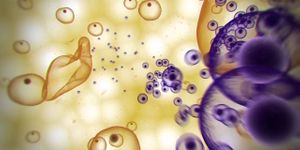Modeling of Cellulose Nanocrystals Suggests Amazing Strength

Crystalline cellulose structures are known to have great strength compared to their weight, but quantifying this on the nanostructural level has been difficult, especially when it comes to nanocrystalline cellulose. Researchers at Purdue University, the GM R&D Center, and the Forest Products Lab at the US Forest Service, used quantum mechanics principles to predict the strength of nanocrystalline cellulose, and concluded that they have a stiffness value in the range of steel. This work was published in the recent issue of Cellulose.
With a nanocrystalline structure in the range of 500 nm (nanometers) in length and widths around 3 nm, their dimensions are similar to carbon nanotubes that are currently used as strength-reinforcing additives in a wide variety of composite applications (everything from airplane and automotive components to golf clubs and tennis rackets). However, carbon nanotubes are relatively expensive to produce; whereas nanocrystalline cellulose could theoretically be recovered out of waste streams from existing industries (such as paper mills or biofuel conversion facilities).
If the strength of nanocrystalline cellulose can be confirmed and their mechanical properties fully characterized, these materials could offer a great alternative as additives to strengthen composites. By definition, they represent a "greener" process-made from renewable materials and potentially from waste streams-and depending on the technology required to extract the nanocrystalline structures, potentially a carbon-neutral product.
The research team was able to model the atomic structure of cellulose with high precision and determined that nanocrystalline cellulose has a Young's modulus value (stiffness) near 206 GPa (gigapascals). For reference, concrete is in the area of 30 GPa, ASTM-A36 steel is approximately 200 GPa, and individual carbon nanotubes can vary from near 100 GPa to 1500 GPa depending on their structure.
Nanocrystalline cellulose could be an economical, green alternative for strengthening additives-and depending on how the structure can be altered and chemically functionalized; it may have a wider variety of uses. Anything from drug delivery vehicles to purification filters to electronics industry coatings is a potential use, if the chemists in that industry can modify the structure for their needs without reducing its inherent strength.
There are other obstacles to consider, aside from convincing industries to invest in recovery processes. Cellulose's biodegradability may be an asset in some applications and an obstacle in others. If the material is being processed as nano-scale particles, it will undergo EPA and health hazard scrutiny just like other nanomaterials. Finally, some form of bulk measurement will eventually be necessary. Some carbon nanotubes in the same predicted stiffness range as individual nanotubes were found to have orders-of-magnitude lower stiffness in bulk measurements, making them useful for some industries and less so for others.
The researchers at Purdue are planning to apply the same research to alpha-chitin, a material abundant in the shells of crustaceans and insects. The mechanical properties are thought to be similar to cellulose, and alpha-chitin is a waste product of the seafood industry, so it could represent another renewable tool for composite designers and materials engineers to use.
This work represents a milestone toward the possibility of greener, renewable, economically viable materials for high-strength, lightweight applications. It's possible that your car or golf clubs will contain some of these materials within a decade or two.








